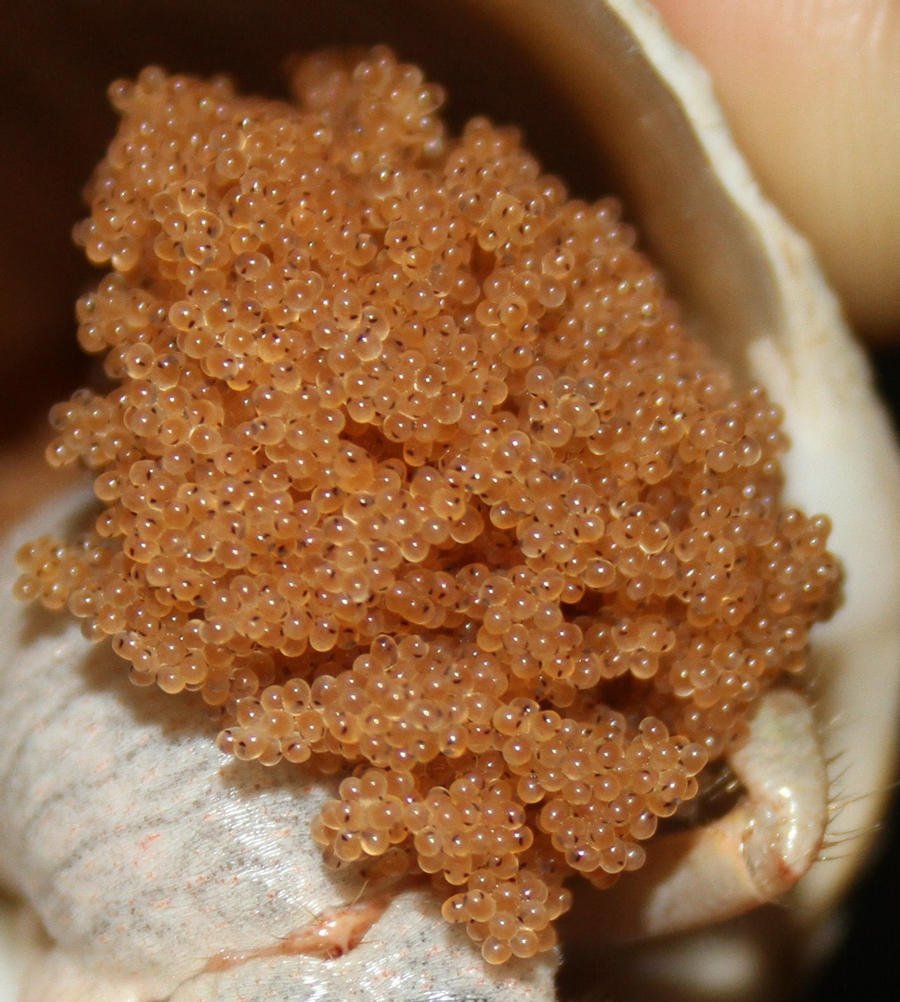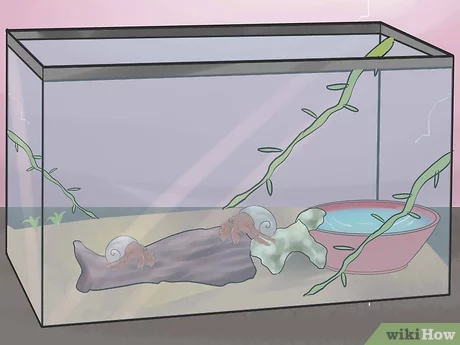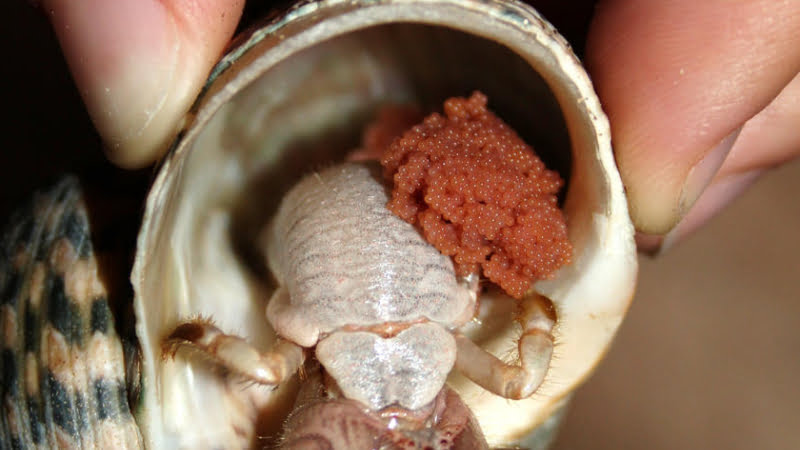Saltwater hermit crabs are a type of saltwater crab that lives in saltwater. They can be found in different parts of the world, but they prefer warmer climates more than colder ones. There is one thing that saltwater hermit crabs have been doing for centuries: laying their eggs!
In this article, we will share with you 5 facts about saltwater hermit crab eggs and why they’re so interesting.
See also:
- Can Hermit Crabs Live Out of Water? (Impressive Answers)
- Why Gorilla Crabs Are Bad Hitchhiker And How To Remove?
Do Saltwater Hermit Crabs Lay Eggs?
Reproduction in hermit crabs has always left us with lots of questions, more so if you keep them as pets. Most people have wonder how hermit crabs reproduce and so, do hermit crabs lay eggs? become questioned.
Many hermit crabs actually attach their eggs to themselves where they are protected. This means that you will never see the eggs without looking at the abdomen of the crab.
Spotting hermit crab eggs is tricky since they rarely change shells when pregnant. When left in captivity, many of their eggs will not hatch at all. Hermit crab eggs need a specific environment to hatch – one that’s different from the salt water or fresh water in which hermit crabs typically live.
It’s nearly impossible to see hermit crabs laying eggs or mating because these decapod crustaceans have nocturnal nature.
Their genitals are located at the far end of their abdomen. So, when a male and female crab come to mate, they have to get out of their shells in order for anything to happen.
The mating process should not take long because the male crab inserts his sperm packet to the female. If hermit crabs stay outside of their shell for too long, other crabs will steal their shells. Luckily, the mating process only takes less than a minute for both hermit crabs. Therefore, it is safe for them.
Newly fertilized hermit crab eggs are typically carried by the mother on her abdomen. She may take some time to find a suitable location for egg deposition, but these eggs will generally not be found in their final resting place prior to hatching.
Saltwater Hermit Crab Eggs Description
If you have hermit crabs as pets, it might be interesting to see their eggs. If you peer into your crab’s shell, it should be possible to see the eggs.
Hermit crabs carry their eggs for around a month. While the eggs are brick red, they occur in clusters and are closely tied together throughout this time. If you monitor them, you’ll notice that as soon as the yolk supply depletes, they change color to dark gray.
Pregnancy generally lasts anywhere from one month. During that time, the hermit crab deposits eggs in its environment. These eggs really only hatch when they come into contact with salt water. Newborn larvae can’t be on land after three months, so they must find shells or else stay wet.

How Many Eggs Do Hermit Crabs Lay At A Time?
The more eggs a hermit crab carries, the larger she will be. The number of eggs she provides multiplies with the fertility of the partner that breeds with her. She can carry more eggs if bred by an experienced male and has been carrying eggs for long periods of time.
Almost all hermit crabs produce eggs in high volumes, with some laying as many as 50,000 at a time. The eggs are small enough that they will not be uncomfortable for the crab.
These 50,000 eggs do not always hatch due to various in-egg dangers, and only reach the most primitive stages of the hermit crab life cycle. This is why females carry so many eggs, with the hope the more new hermit crab can survive, the better it will be.
Saltwater Hermit Crabs Lay Eggs In Captivity
Female hermit crabs in captivity are not typically interested in mating because they cannot lay their eggs safely.
On the theoretical basis, convincing saltwater hermit crabs to breed is possible. This process, however, requires your patience and a special environment. All you need is to trick the female crabs to think that she is now in the wild which is similar to her natural habitat. Doing this takes you time and resources that are sometimes beyond your reach.
There is no need to separate the males and females in your tank. Females will still come into their season, while males will still show their interest. They are not biologically programmed to mate with most females outside of her species, though.

What Should You Do If Your Saltwater Hermit Crab Lays Eggs?
Of course, if you take care of your hermit crabs by providing what they need, then a female may lay eggs. Unfortunately, there is little you can do to create better conditions for the hatching of hermit crab eggs.
It is important to understand that saltwater hermit crabs cannot reproduce or deposit their eggs in captivity. This means the little ones will never be able to produce hatchlings because they are not physically nearby.
The owners usually do not realize the signs when salt hermit crabs are pregnant. As the result, they will lay their eggs without your notice.
FAQs
What do hermit crab eggs look like?
Hermit crab eggs start out looking as bright as bricks for the first few weeks after the female begins to carry them. Eventually, they will grow increasingly large and cause the hermit crab’s abdomen to swell.
Hermit crab eggs are a bit different from most organisms we see in the wild. Hermit crab eggs have to protect their larvae, so they often do not give off as vibrant of colors as other animals. The closer these hermits get to hatching, the less colorful they will become. As the development of an egg sac finishes, a hermit crab has turned dark gray.
How often do hermit crabs breed?
Female hermit crabs will try to reproduce for their first year of life, even if the chance for successful breeding is low. Pregnancy can freeze molting and growth cycles, either prolonging time on a small shell or giving that opportunity to other hermit crabs in the community.
Male hermit crabs are more likely to mate often, as long as there is a nearby female. Hermit crabs generally live in large groups and this is the reason why they are seldom not in the breeding period.
Hermit crabs do not take an active role in raising their young or protecting them. For hermit crabs, the safety of numbers applies. Therefore, the more hermit crabs that breed, the safer they are from predators.
Hermit crabs have a selfish reason for producing eggs as well. As with most sea creatures, there is an ever-shortening supply of shells available to them, and once one crab dies, another occupies their vacant shell.
Hermit crabs live in shells and need a constant availability of them. As with many living things, the more crab friends they have, the likelier this becomes. Current Biology describes this case as social dependence.
What is the ideal hermit crab breeding age?
Hermit crabs do not experience menopause so theoretically they can breed at any age. Most hermit crabs are driven to reproduce while young, though. There are two explanations for this behavior:
Do hermit crabs breed in captivity?
There’s a belief that crabs in captivity never mate, but research has shown this is possible. It requires patience and luck, though. Mating among them remains rare – almost non-existent – in captivity
New environments can be a challenge for new hermit crabs. As discussed above, some females need to think they’ve been transported to the wild in order to breed successfully.
Breeding hermit crabs in captivity is never a guarantee. These creatures are very particular. Females won’t mate unless the conditions are perfect, and males can only reproduce if their mood is just right (this means they don’t feel any stress from their impending meeting).
Conclusion
To sum up, hermit crabs do not give birth, but they lay eggs. The eggs rarely survive to see the next stage in the development of their lives as baby crabs. The only way hermit crab eggs will survive is if they are deposited in saltwater; without that, there is no hope for their survival. Therefore, if you are thinking about breeding hermit crabs, think again.
Hope my article is informative and interesting to you and thanks for spending time reading it.

Annette M. Chaney is an experienced marine biologist with over 20 years of experience as an aquarist and fishkeeper. She started her first aquarium at a young age, filling it with frogs and goldfish obtained from the ten-cent pet store.
Annette grew up caring for and breeding African Cichlids, which led to a hobby in high school that doubled as a profitable means. Attending Reed College gave her time to solidify herself as an accomplished aquarium caretaker with an eye for sales. After that, from 2009 – 2013, she studied at Roger Williams University – one of the most prestigious universities for Aquaculture and Aquarium in USA. She is the founder of AquariumCircle since 2010.
